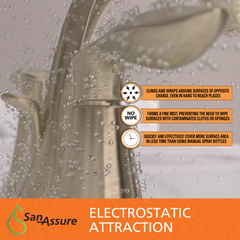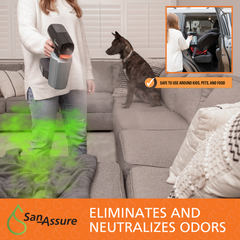

Have you ever tried to spritz 100 square feet? What about 1000?
Have you tried to disinfect or clean a room, knows the specific pain of spritzing the bottle repeatedly. At times, I switch to my nondominant hand to relieve the pain.
Using a battery-operated electrostatic sprayer can help facilities navigate the “new normal” of clean needed to meet post-pandemic standards. But how do you know if your disinfectant is effective after it has been sprayed? How do I know that the chemical is being charged to wrap around surfaces? Is the chemical sprayed so finely that it can penetrate the skin and lung tissue?
In the wake of the pandemic and misleading claims in the marketplace, the EPA started adding guidance and regulation to sprayers and the chemicals they use. Even with the new guidelines and regulations, it can also be difficult to sort through the different options and select a device that will meet specific facility and operator needs.
San-Assure Sprayer: Proven to Meet EPA's Newest Guidelines and Requirements
Electrostatic sprayers can help facilities disinfect or sanitize large areas in far less time than would be required when using manual trigger spray and wiping methods. These benefits are important, but without full government regulation in the space, what is the best way to determine if an electrostatic sprayer holds the true capabilities associated with this innovative technology? Device safety, functionality, ease of use and proof that the technology works in practice are all critical factors to consider when evaluating electrostatic sprayers.
Selecting an Electrostatic Sprayer
The most important considerations when choosing a device include sprayer design, system safety, ease of use and proof of performance. When considering which disinfectants and sanitizers to use through the device, choose products that are EPA-registered and have language on the master label that lists electrostatic spraying as an approved application method. Use of a disinfectant or sanitizer in a manner that is not listed on the EPA master label (such as through an electrostatic sprayer) is a violation of federal law.
System Safety
Specific chemistries should be assessed with specific sprayers to determine personal protective equipment (PPE) requirements for the operator and to make sure there is no re-entry time for bystanders. Companies like San-Assure that manufacture both devices and chemistries are best positioned to provide this type of safety assessment because they can test them as a paired system. While disinfectants may be safe to use through electrostatic sprayer systems, a risk assessment is crucial because the PPE requirements for applying a product through a trigger sprayer may differ from the PPE requirements to apply a product through an electrostatic sprayer. Without a safety assessment, the user does not know if the device and chemical are safe when used together. The manufacturer should be able to provide an SDS for each disinfectant or sanitizer recommended for use with the sprayer that contains information on the appropriate PPE recommended for use through the sprayer.
The type of chemistry used can also impact safety recommendations. Some formulas will be suitable for use through a trigger sprayer but may cause excessive fragrance odor or irritation if applied through an electrostatic sprayer. Disinfectants that are specifically designed for electrostatic sprayers are best because they contain minimal ingredients and no fragrances. Each disinfectant must also be tested through a specific electrostatic sprayer to ensure that the levels of product emitted into the air are below established limits. Facilities should also consider whether solutions are ready-to-use or if they require dilution prior to use. Dilutable products can be less expensive than ready-to-use products, but they introduce extra time and labor into the application process, increase the potential for human error, and pose an increased safety risk if chemicals are mixed improperly.
Ease of Use
Operator experience is also important. Whichever device and chemistry combination you choose, make sure the manufacturer can provide training for your personnel. They should also be able to provide the SDS for each disinfectant or sanitizer recommended for use with the sprayer, including information on the appropriate PPE to wear when using each product through the sprayer. Devices should be ergonomically designed so that operators can use them comfortably throughout the course of their shift.

System Performance
It’s important to consider whether an electrostatic sprayer delivers everything it claims. Both testing by the manufacturer and real-world testing are important factors in demonstrating a system’s performance. Manufacturer testing could include for example efficacy testing in a laboratory, surface compatibility testing, object wrap demonstration, cost benefit analysis, and surface coverage rates. Real world testing could include cost analysis, efficacy confirmation, compatibility with surfaces in a facility, surface coverage rates compared to manual disinfection, and impact on related outcomes like staff or building occupant absenteeism or infection rates such as MRSA infections in athletes or norovirus cases in schools. There are many factors that influence infection transmission, but frequent surface cleaning and disinfection can help eliminate the environment as a source of infection.
The disinfectants and sanitizers used in electrostatics sprayers must be EPA-approved, but the electrostatic sprayers themselves are not EPA-regulated. As such, there are no standard testing methods for evaluating electrostatic sprayer devices in the surface disinfection industry. For this reason, it is important to get as much information as possible from the manufacturer on their device testing. Only EPA-approved disinfectants or sanitizers that have electrostatic spraying listed as an approved application method on the label should be used through electrostatic sprayers. Additionally, the EPA is now requiring manufacturers to provide data showing that their sprayer delivers the expected efficacy when those disinfectants and sanitizers are passed through the sprayer.
The most rigorous way to demonstrate efficacy in the real world is through surface swab testing, which reveals how many live microorganisms were on surfaces before versus after disinfection, and can also reveal whether specific microorganisms were present, such as MRSA. Adenosine triphosphate or ATP testing, on the other hand, is a tool that can be used to demonstrate overall cleaning or removal of organic dirt and debris from surfaces, but it cannot tell the user whether or not there are live microorganisms on those surfaces. ATP testing should be used as a training tool for cleaning staff, and not as a method to assess disinfection. Be wary of any studies on electrostatic sprayers that attempt to use ATP testing to demonstrate efficacy.
Surface compatibility testing is also important, since compatibility of a chemical when applied through an electrostatic sprayer can differ then when applied via a wipe or trigger spray. Generally, compatibility will be superior when an electrostatic sprayer is used because less liquid is applied to surfaces and the coating is more even than a wipe or trigger spray application. Manufacturers should also be able to demonstrate how well their electrostatic sprayer delivers disinfectants and sanitizers to all sides of complex objects, which is a key indicator of performance.
Cost benefit analysis supported by data can also help demonstrate a sprayer’s value. Ask electrostatic sprayer manufacturers for information on surface coverage rates as well as methodology describing how those rates were determined. Both the volume of liquid that a sprayer can disperse per hour as well as the contact time of the disinfectant or sanitizer being applied through the sprayer should be taken into account. For example, a sprayer that covers up to 18,000 square feet per hour with a 30-minute continuous spray time using a disinfectant that has a contact time of two minutes could save facilities time and labor when used in large or difficult-to-disinfect areas. As facilities re-open post-pandemic, many are disinfecting more frequently and also disinfecting more areas of the facility than they did previously. Electrostatic sprayers can help facilities meet these new requirements.
Real-world evaluations of electrostatic sprayers are just as important as manufacturer testing because they confirm that a product can deliver what it claims in practice. The results of real-world studies should be published in reputable journals or provided by the manufacturer in the form of a study summary. Ask device manufacturers if they have partnerships with reputable facilities to generate real-world evidence to support their sprayer technology.
Electrostatic spray technology is more than a device – it’s a system. Before purchasing an electrostatic sprayer, consider whether the technology you are investing in is safe, trusted and proven. A technology that performs as intended can help facilities demonstrate a commitment to providing a safe environment for both staff and the people that use the spaces being treated.
(See, EPA.gov and Evaluating Electrostatic sprayers for surface disinfection by Katherine Velez, Ph.D, Senior Scientist at Clorox Healthcare, Facilities Management.com. )
Navigation
Search
About
Technology
Resources
Professional Use
Contact
Newsletter
Accessibility
Terms of Service
Refund Policy
Privacy Policy
Warranty Registration
Contact us
About us
San-Assure provides multi-surface cleaning solutions that allow you to disinfect and sanitize every surface in your home. Our EPA-Registered sanitizer is safe to use and our electrostatic attraction technology provide full coverage disinfecting.
*simulated image.












